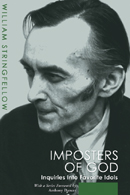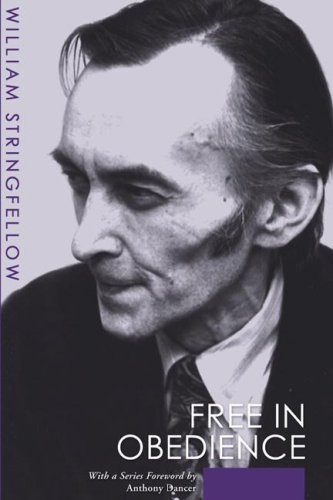 After chapters on money and status (pp. 31–6), race (pp. 39–43), and patriotism (pp. 47–52), Stringfellow, in Chapter Seven, turns to the idol named ‘Church’. He recalls that by the sheer gift of God, the Church lives in the midst of a history constituted by the Fall and in ‘juxtaposition to each and every institution and ideology in their fallenness’ for the critical purpose of ‘being a witness and example of the society of mankind and of all creatures liberated from the power of death’ (p. 55). In building his argument, Stringfellow considers the very constitution of the Church at Pentecost, where, he notes, arise two peculiar characteristics which distinguish the Church as free from the power of death. Both, he insists, pertain to the Church as renewed creation, that is, both inhere in the unity of the Church, bestowed in Pentecost by God for the sake and service of the world. He names these characteristics the ‘secular unity’ of the Church and the ‘churchly unity’ of the Church:
After chapters on money and status (pp. 31–6), race (pp. 39–43), and patriotism (pp. 47–52), Stringfellow, in Chapter Seven, turns to the idol named ‘Church’. He recalls that by the sheer gift of God, the Church lives in the midst of a history constituted by the Fall and in ‘juxtaposition to each and every institution and ideology in their fallenness’ for the critical purpose of ‘being a witness and example of the society of mankind and of all creatures liberated from the power of death’ (p. 55). In building his argument, Stringfellow considers the very constitution of the Church at Pentecost, where, he notes, arise two peculiar characteristics which distinguish the Church as free from the power of death. Both, he insists, pertain to the Church as renewed creation, that is, both inhere in the unity of the Church, bestowed in Pentecost by God for the sake and service of the world. He names these characteristics the ‘secular unity’ of the Church and the ‘churchly unity’ of the Church:
The secular unity of the church at Pentecost consists in the extraordinary transcendence, in that event in which the church is called into being, of all worldly distinctions familiar to men. Thus, according to the biblical testimony, on the day of Pentecost there are gathered in one place men of every tribe and tongue who are, in becoming the new society of the church, no longer divided and separated and unreconciled on account of their differences of race or language, ideology or class, nationality or age, sex or status, occupation or education, or, indeed, even place and time (Acts 2). Such distinctions, so esteemed in the world that they are representative of the idols men worship and vainly look to for justification, are surpassed in such a way in the establishment of the church in history that the church is characterized, biblically, as “a new creation,” “a holy nation,” “a priest among the nations,” “a foretaste of the Kingdom of God,” “a pilgrim people,” “a pioneer of salvation,” “a new race,” a community in which there is neither Jew nor Greek, bond or free, but in which all have become one in Christ.
Coincident with this worldly unity of the church at Pentecost is a churchly unity encompassing the manifold charismatic gifts bestowed upon the church and distributed and appointed among members of the church, such as prophetism, preaching, teaching, healing, administration, speaking in tongues, and so on. (See Ephesians 4:11–14, cf. 1 Corinthians 14:1–19.) These particular gifts of God to the church are missionary gifts – that is, they are entrusted to the church and authenticated in their exercise by members of the church as means of witness and service to the world. At the same time, according to the biblical precedent, the efficacy of a specific gift requires the presence and use of all the other various gifts so that they are all interrelated and interdependent, and so that each enhances the wholeness of the body of the church. The diversity of charismatic gifts is not occasion for division of the church into sects or parties or for status distinctions or exclusionary practices among members of the church. The gifts are contributions to a churchly unity which serves a broken, divided, fallen world as a forerunner of the reconciliation vouchsafed in Christ for the world.
It is possible to speak of the marks of the church in other frames of reference which are both trustworthy and worthwhile, but it is never possible to omit these two marks of the church manifested in the constitution of the church at Pentecost. (pp. 56–7)
Stringfellow proceeds to note that ‘a distinctive mark of the biblical mind’ is the ability to ‘discern that human history is a drama of death and resurrection and not, as religionists of all sorts suppose, a simplistic conflict of evil vs. good in an abstract sense’ (p. 64). God has embodied the aspects of the essential conflict between life and death into his own drama of death and resurrection: ‘In the light of the Gospel, every life, every person, every event, is included in the context of death and resurrection – of death and the resurrection of life, of death and transcending the power of death. As death is not just something which each of us must eventually face, but a power at work here and now, so the power of the resurrection is neither something remote nor merely promissory. The resurrection of Jesus Christ means the available power of God confronting and transcending the power of death here and now in the daily realities of our lives’ (pp. 64–5).
It is to this truth that the Church is elected, called and empowered to bear witness. This election, calling and empowerment takes place in the event of Jesus’ resurrection. This event announces the end of the reign of death and inaugurates the new creation in which we need no longer fear the power of death, and so we need no longer serve any idols:
The resurrection constitutes freedom for men from all idolatries, whether of race or money or church or whatever. It constitutes freedom from death as a moral power in history, freedom to welcome and honor life as a gift, freedom to live by grace, unburdened by the anxiety for justification which enslaves men to idols.
In this freedom, we can begin to be faithful to our own humanity, and so faithful to God. We can go to work to give back to our various idols their true nature and purpose in relation to human beings and human living: to love our country and try to restore it to a sense of its true vocation in the family of nations; to use money as a medium facilitating equable exchange of goods and services; and try to get it so used in our society and in our world, and so on.
In this freedom, we no longer serve idols in our work or other experiences; we serve the living God. We work in the service of life, for ourselves and our fellow men. We work to re-establish human life in our relationships with ourselves and others and things in our society, anticipating in hope the final restoration when God will be “all in all.”
Thus work takes on the character of worship “in spirit and in truth,” and in our worship we celebrate the life and restoration we are working for. In such freedom, then, the present obvious dichotomy between what Christians do in the sanctuary and what they do in society can be done away with. What is affirmed and enacted in our corporate liturgical worship is what we affirm and work for in our daily lives. In both, we celebrate the gift of life as such by participation in God’s affirmation of life in the face of death. (pp. 65–6)
Imposters of God, which began its life as a study book for high school students, has been described as a work which ‘exposes the reality of idolatry at the heart of our common life in the world: work, status, money, race, the church, etc. But perhaps most importantly, it provides hope: a way of living in grace’ (Anthony Dancer). Yes it does. And Karl Barth was right about Stringfellow when he said, ‘You should listen to this man!’
Don’t forget Wipf & Stock’s offer to readers of Per Crucem ad Lucem of 40% off the retail price of any of the Stringfellow volumes. To obtain the 40% discount, just include the coupon code STRINGFELLOW with your order.





